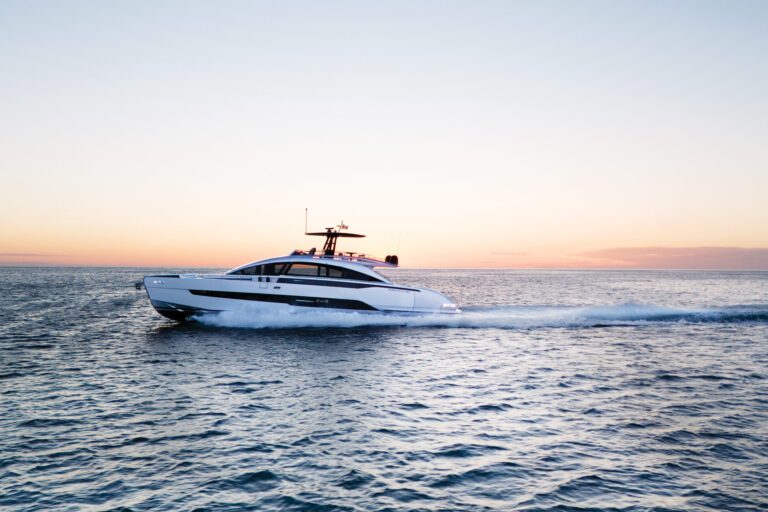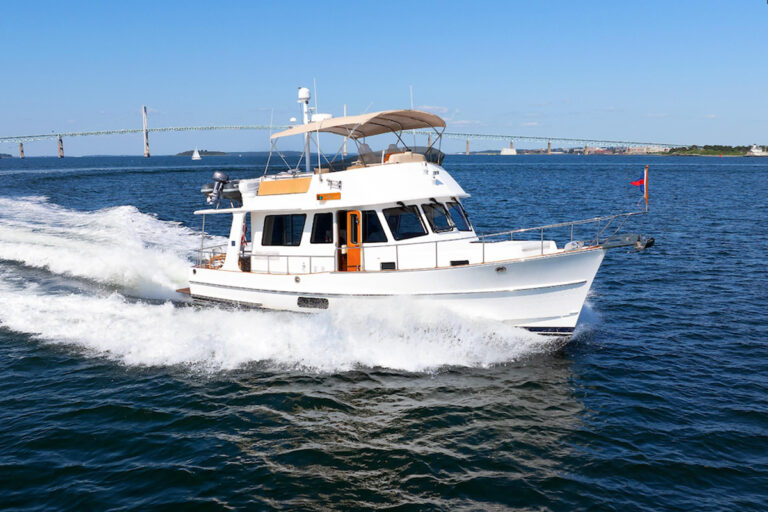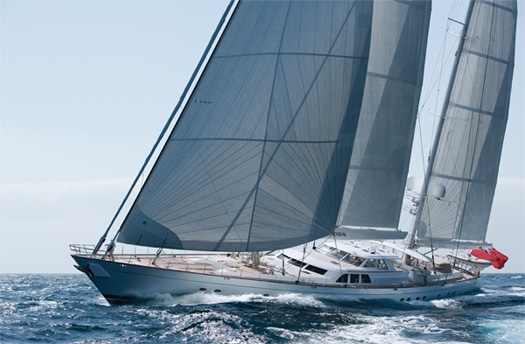
ytgoct23rh525.jpg
It was love at first sight, but it took 15 years for the flirtation to reach fruition. Juliet, a 143-foot ketch, was delivered by Royal Huisman Shipyard in 1993, and it was not Romeo, but Bill Joy, cofounder of Sun Microsystems, who was smitten early on by the lovely lady from Holland. Alas, she belonged to another, but the flame she sparked continued to burn in Joy’s heart.
Joy has been called “the Edison of the Internet” by Fortune magazine for his dozens of patents in the field of computers and electronics. He was Sun’s chief scientist for 21 years until he left the company in 2003. That change allowed him the time and opportunity to fulfill his longheld dream, the creation of a yacht inspired by Juliet, yet taking full advantage of the technological advances of the intervening years and the opportunity to try out more than a few additional ideas of his own.
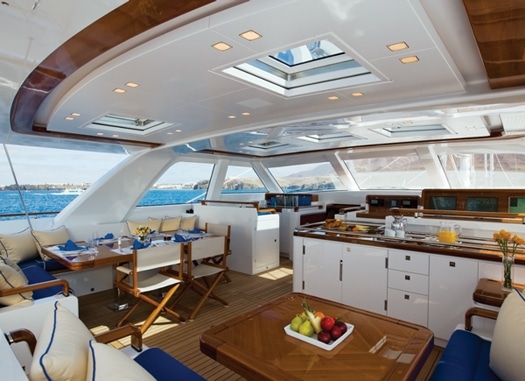
| | |
The stunning result is the aptly named Ethereal. She’s a 190-foot ketch from the same team that created Juliet-Royal Huisman as builder, Ron Holland as naval architect, and Pieter Beeldsnijder as designer. The addition of Bill and Shannon Joy to the lineup as owners clearly inspired the original three teammates to even greater goals. While Ethereal bears a family resemblance to Juliet, she is a considerably more sophisticated vessel under the skin. Joy describes her as “a floating lab,” and he is on the mark in certain respects, perhaps most of all in having the yacht be as environmentally friendly as possible for her size.
Considering that Al Gore, of An Inconvenient Truth fame, is one of Joy’s partners in his new career with the venture capital firm of Kleiner Perkins Caufield & Byers, it is not surprising that Ethereal sets a new standard for green yachts. Another partner at KPCB, Tom Perkins, is an active and lifelong sailor, and was the force behind Maltese Falcon, the super-clipper best known for her unique DynaRig mast system.
From such a pedigree and such a support network has sprung a yacht like no other. The yacht’s hybrid propulsion system is just one element in an integrated onboard network that encompasses everything from energy management, to the layout of the interior, to the smallest piece of auxiliary equipment, but it is as good a place to start as any.
Imagine that Ethereal’s guests have enjoyed the delights of Portofino well past evening and into the wee hours of the morning, so as the sun rises, they slumber on while the yacht leaves her mooring. The thruster, nearly silent due to its cavitation-supressing hubless design and electric drive, nudges her bow around, and the 300-kilowatt electric motors built into the propulsion drive train are engaged to move her quietly out of the confines of the harbor and into the open Mediterranean. Sails are hoisted and trimmed by wireless remote control, and a course is set for Sardinia. Under full sail, Ethereal’s propeller windmills, which drove the electric propulsion motors, now operate as generators to recharge the 400-kilowatt-hour lithium-ion phosphate battery bank that powered her silently out of the harbor earlier in the morning.
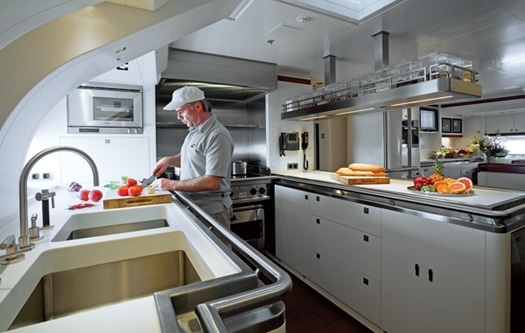
| | |
As the guests arise to the slight heel and gentle motion of the hull under sail, brunch is served. It was prepared without need of the diesel generators, thanks to batteries and inverters that power central AC and DC bus systems. After brunch, a couple of the guests opt to take in the view from one of the two crow’s nests that travel the forward edge of the masts, while other guests relax on deck. When the wind drops, the main engines are fired up to boost Ethereal’s speed and to recharge the battery bank further.
The battery system can also be used to heat and cool the interior when the yacht is in silent mode, something that would not be practical were it not for myriad complementary considerations. While almost all yachts have deck and hullside insulation for both sound and thermal purposes, the accommodation spaces aboard Ethereal are further wrapped in a cocoon that minimizes heat transfer. Hatches are fitted with two layers of light-switchable glass to block or admit light as desired.
While this keeps heat out, it also traps any heat that originates within the space, so that heat generation is minimized wherever possible. For instance, energy-efficient light-emitting diodes (LEDs) are used in place of incandescent or halogen bulbs, putting nearly all of the wattage used into light rather than waste heat. A special lens system softens the stark-white glare that is often objectionable with LEDs.
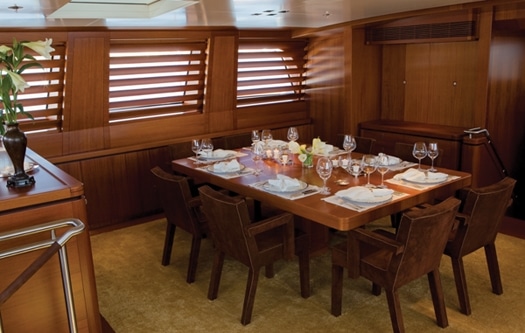
| | |
The air-conditioning system utilizes ducts rather than local fan-coil units, so the heat from fan motors in each room is nonexistent. Heat from galley and laundry equipment is ducted outside, and the highvisibility backlit screens in the pilothouse, with 10 times the daylight viewing power of a typical laptop screen, are-get this-watercooled.
As a result of all this attention to technical detail, the traditional diesel generators aboard Ethereal are 90 kW each rather than the expected 140 kW for a yacht of this size. In addition, by load-sharing at intermediate usage levels with the battery-powered inverters, very often it is necessary to operate only one generator rather than two, allowing the crew to provide exactly the power needed and avoiding the wasteful use of electrical load banks.
Additional energy savings are realized by using the waste heat from generator cooling water for freshwater heating and as a supplement to the air-conditioning system when operating in the heating mode. Likewise, stale discharge air from the accommodations is used to precondition incoming fresh air. The still-substantial pressure of the watermaker discharge water is used to pre-pressurize incoming supply water, saving about 4 kW in the process.
While all this “floating lab” stuff is very impressive and of tremendous interest to a gearhead like me-not to mention very important to Bill and Shannon Joy-the fact remains that Ethereal is, after all, still a yacht. As such, she should sail well and should host her guests in comfort and safety. Happily, those aspects of her being have not been compromised for the sake of technology. Her builder and her naval architect refer to her as a “performance ketch,” and her captain confirms it.
The Joys wanted a “perfect mobile gathering place for family and friends,” and that’s just what they got. “We prefer Zen to ornate,” Joy said. While the hand-rubbed, inlaid mahogany interior is far from minimalist, it is still tastefully clean and uncluttered. “You don’t have to put any art on these boats,” continues Joy. “The boat itself is the art.” That’s especially true of yachts built by Royal Huisman Shipyard, which has one of the finest woodworking shops in the industry. Alice Huisman now heads the 125-year-old yard bearing her family’s name, but it was Alice’s father Wolter who first showed me around the shop when it was completed a few years ago. He pointed with pride to the pneumatic lift-and-tilt worktables and to the escalator between the main work floor and the supply rooms on the upper level. Having started as a carpenter himself in the yard, he understood that by reducing worker fatigue and injuries, the yachts would benefit through interiors of exceptional quality.
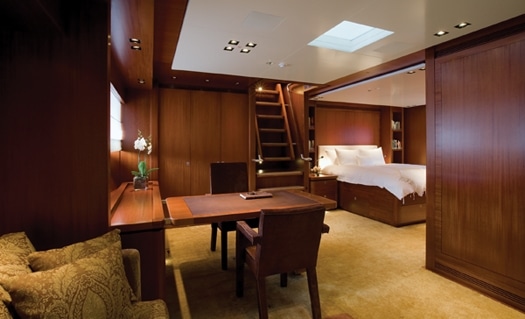
| | |
Ethereal hosts up to eight guests in three staterooms and a convertible den abaft the engineroom. An additional couple are accommodated at the stern in the full-beam owner’s suite, which includes a cedar-lined sauna and direct access to the aft cockpit and swim platform. The lower salon has a huge flatscreen TV to port, plus a music area to starboard, complete with piano and an ensemble of percussion instruments. The upper salon seats 10 for dinner at a table to starboard, and a seating area and game table to port can be converted to seat eight more.
Even without the innovative technology lying behind her beautiful joinery, Ethereal would be a special yacht, but the “floating lab” aspect makes her all the more remarkable. Kermit the Frog famously commented that it’s not easy being green, but Ethereal proves that it’s well worth the effort. She, through the combined efforts of her owners, builder, and designers, has shown what is possible-and, hopefully, she will inspire others to help sustain the sea that makes yachting such a pleasurable pastime for all of us.
Royal Huisman Shipyard, +31 527 243 131; **www.royalhuisman.com**

